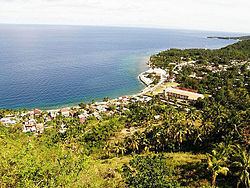Country Philippines Barangay ZIP code 6024 Local time Monday 6:20 PM | District 2nd district of Cebu Time zone PHT (UTC+8) Area 117 km² Province Cebu | |
 | ||
Region Central Visayas (Region VII) Weather 28°C, Wind N at 18 km/h, 82% Humidity Points of interest El Gran Baluarte de Boljoon, Boljoon Church, Mediong's Seaside Escape R, Boljoon Parish Museum, Baluarte sa Fuente | ||
Boljoon (also Boljo-on) is a 5th municipal income class municipality in the province of Cebu, Philippines. According to the 2015 census, it has a population of 16,344. In the 2016 electoral roll, it had 10,216 registered voters.
Contents
- Map of Boljoon Cebu Philippines
- Barangays
- Demographics
- Boljoon Church
- Discovery of 16th century artefacts
- References
Map of Boljoon, Cebu, Philippines
Boljoon has a total land area of 117.00 km2 (45.17 sq mi). It is bounded to the north by Alcoy, to the west by Malabuyoc, to the south by Oslob, and to the east by Bohol Strait.
Barangays
Boljoon comprises 11 barangays, of which six (including Poblacion) are coastal, and the rest inland:
Demographics
In the 2016 electoral roll, it had 10,216 registered voters, meaning that 63% of the population are aged 18 and over.
Boljoon Church
Nuestra Señora de Patrocinio Parish Church of Boljoon shows old and intricate carvings and bas-reliefs. It is in a pseudo-baroque rococo style. It has a main nave, a transcript, and twenty-eight pillars which support the walls. The walls are as thick as the pillars which are 2 metres (6 ft 7 in) thick and made of mortar and lime.
Boljoon became a visita of Carcar founded according to some authors in 1599. It became an independent vicariate on 31 October 1690, and on 5 April 1692, Fr. Nicolas de la Cuadra was appointed as prior. Because of the lack of priests, the church was turned over to the Jesuits on 27 September 1737, following the recommendation of the intermediate chapter of 1732. In the year 1747, the General of the Augustinians Order proposed the recovery of the parishes left off in the Visayas.
Boljoon's earlier building had been destroyed in a raid in 1782, and its pastor Fr. Ambrosio Otero started rebuilding the following year. The work was continued by Fr. Manuel Cordero in 1794 but when Fr. Julian arrived, the work was not yet completed. He decided to build a blockhouse 120 by 80 metres (390 ft × 260 ft) on which artillery was mounted, and he enclosed the church perimeter with a wall. He finally completed the church. The church and the adjoining convento were restored by Fr. Leandro Moran (1920–1948) the last Augustinian friar to be assigned to Boljoon.
In 1999 the National Historical Institute declared it a National Historical Landmark. The following year, the National Museum declared it as a National Cultural Treasure.
Nuestra Señora de Patrocinio Parish Church was lucky enough to withstand the 7.2 magnitude earthquake in 2013 that affected Bohol and Cebu.
Discovery of 16th-century artefacts
On February 2008, archaeologists discovered 26 human remains (with china plates on top of heads) and 16th-century artefacts beneath the parvis of Boljoon Church.
